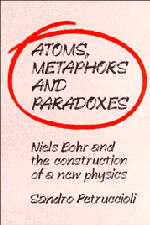Book contents
- Frontmatter
- Contents
- Introduction
- 1 The paradigm of complementarity
- 2 Atomic model and quantum hypotheses
- 3 The principle of correspondence
- 4 The theory of virtual oscillators
- 5 The conceptual foundation of quantum mechanics
- 6 The Bohr—Einstein confrontation: phenomena and physical reality
- General bibliography
- Name index
- General index
5 - The conceptual foundation of quantum mechanics
Published online by Cambridge University Press: 10 November 2009
- Frontmatter
- Contents
- Introduction
- 1 The paradigm of complementarity
- 2 Atomic model and quantum hypotheses
- 3 The principle of correspondence
- 4 The theory of virtual oscillators
- 5 The conceptual foundation of quantum mechanics
- 6 The Bohr—Einstein confrontation: phenomena and physical reality
- General bibliography
- Name index
- General index
Summary
‘Sprache und Wirklichkeit in der modernen Physik’ is the title of a lecture Heisenberg gave in 1960 at the Bayerische Akademie der Schönen Künste. The polemics that had accompanied the establishment of quantum mechanics were over by then and the so-called problems of its foundations had lost much of their initial interest. Einstein had been dead for some years. Right up to the end he had expressed his profound dissatisfaction with a theory which, in his opinion, had something unreasonable about it. With the volume dedicated to him by the community of physicists and philosophers, the long debate between Bohr and Einstein had come to an end. It had been a disappointing conclusion, marked by the reaffirmation of the respective viewpoints of two scientists who by now found great difficulty even in defining a common code of communication. As though seeking to narrow the gap between them, Heisenberg took the opportunity to underline the existence of a common feature in their contributions to 20th century physics. Their discoveries had in fact made it possible to recognize that ‘even the fundamental and most elementary concepts of science, such as space, time, place, velocity, have become problematic and must be re-examined’. The conceptual and cognitive implications of relativity and of quantum mechanics were obviously different but Heisenberg maintained that both theories asked the same question: ‘Does the language we use when we speak of experiments correspond to the artificial language of mathematics which, as we know, describes real relationships correctly; or has it become separated from it so that we must be content with imprecise linguistic formulations and only return to the artificial language of mathematics when we are forced to express ourselves with precision?’.
- Type
- Chapter
- Information
- Atoms, Metaphors and ParadoxesNiels Bohr and the Construction of a New Physics, pp. 134 - 182Publisher: Cambridge University PressPrint publication year: 1993



